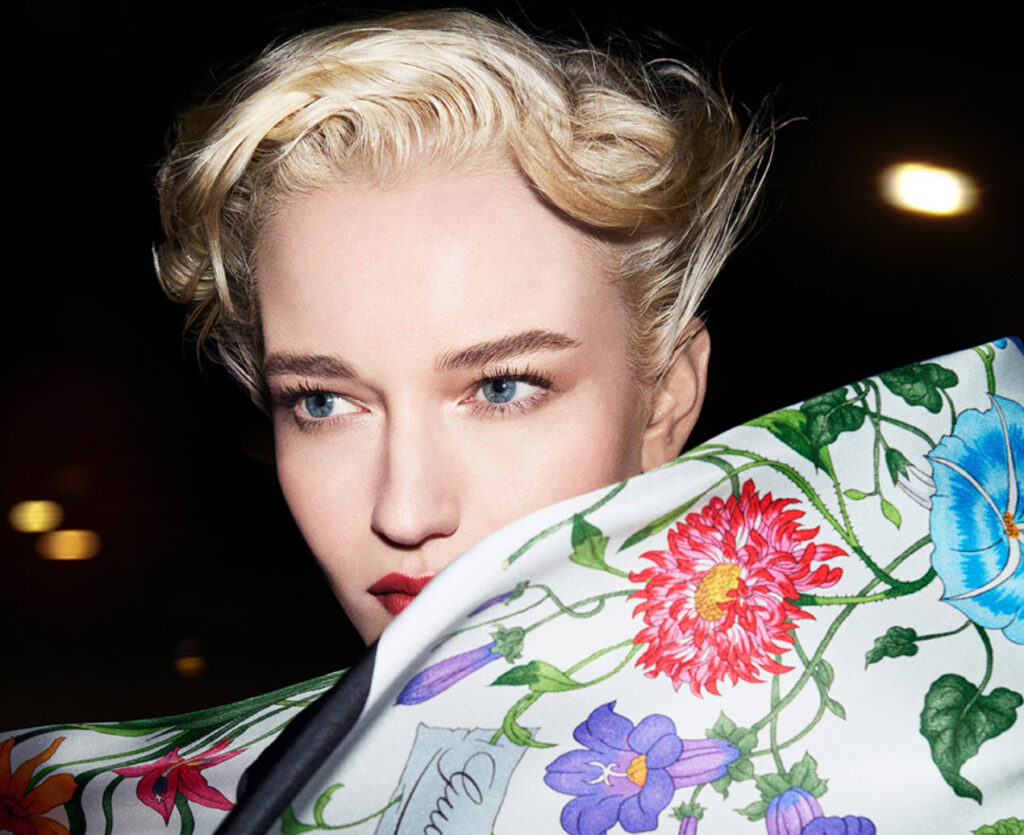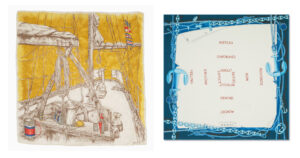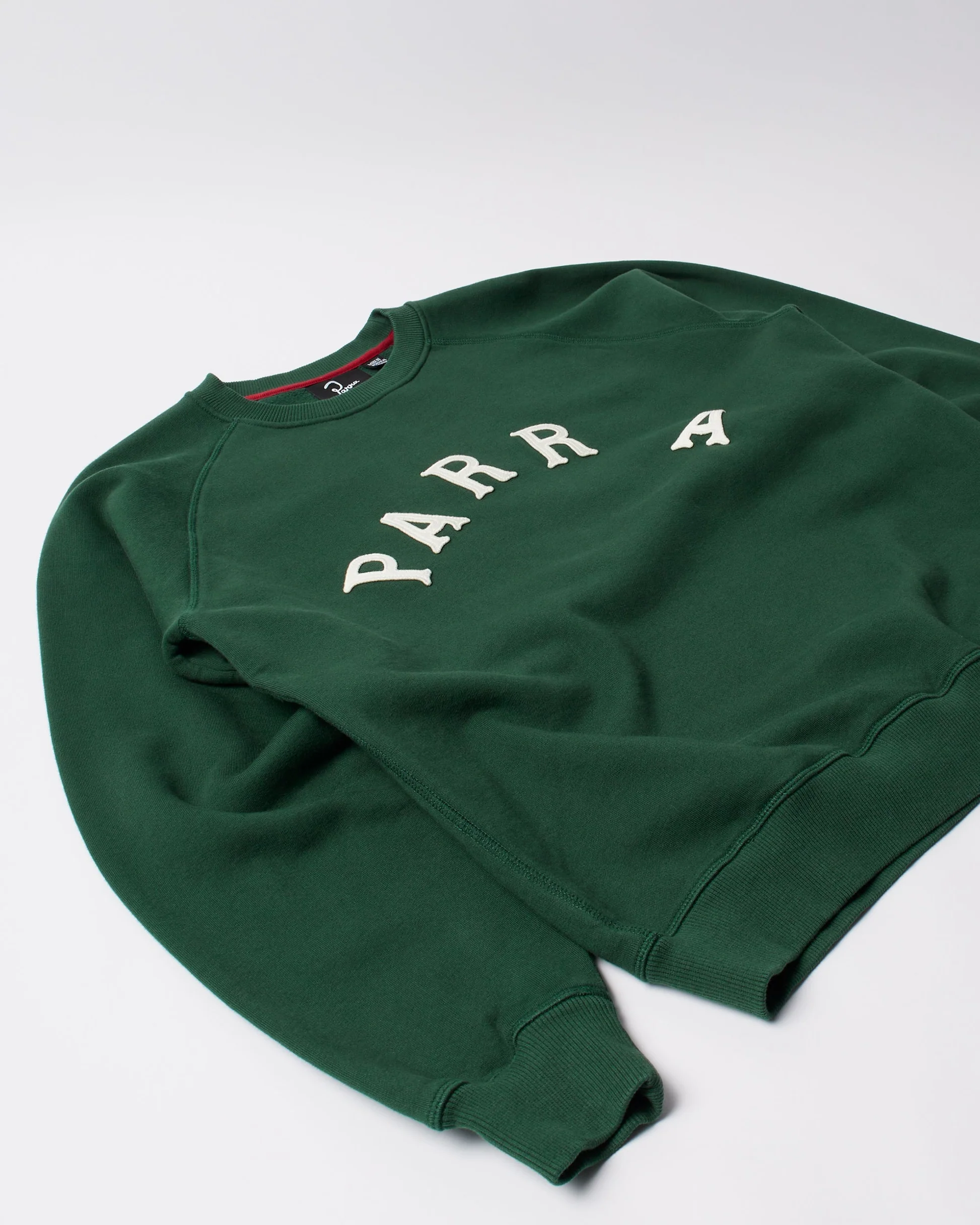Nine artists. One book. A Meisel-lensed campaign starring Julia Garner. Gucci honors its silk scarf history with vision and flair.
Silk at Gucci has never been just silk. Since 1958, it has been an emblem—a canvas, a language, a statement. With their latest cultural project, The Art of Silk, Gucci reclaims that heritage and reframes it for a new generation. Announced on March 21, the project arrives not as a mere collection drop, but as a multifaceted tribute to the house’s past, present, and future. Featuring scarf reinterpretations by nine contemporary artists, a coffee-table retrospective, and a lush campaign by Steven Meisel starring Julia Garner, this is Gucci not simply honoring its archive—but expanding it.
In an age when fashion cycles faster than ever, Gucci is making a different move: pausing, reflecting, and inviting the world to look again. Not just at a product, but at a practice.
A Thread from the Past
To understand The Art of Silk, you have to start in 1958. That’s when Gucci, already known for fine leather goods and equestrian-rooted accessories, began producing silk scarves in its Florentine workshops, sourcing the material from the legendary silk-producing district around Lake Como.
Their first official scarf design, Tolda di Nave, was an ode to the nautical—a ship deck scene set against a warm yellow backdrop, intricate and optimistic. It reflected a post-war Europe eager to dream again. Over time, nautical motifs became something of a Gucci house code, forming a thematic foundation that would grow in richness under the creative vision of artist Vittorio Accornero di Testa.
Accornero, who joined the house in the early 1960s, became the maestro of Gucci silk. He introduced animalia prints, fairytale florals, and most famously, the Flora scarf—a riotous, hyper-detailed print created for Princess Grace of Monaco in 1966. It remains one of the most celebrated motifs in fashion history.
With Accornero’s work, Gucci scarves became not just accessories, but artworks. And now, The Art of Silk returns to that original impulse: silk as story, silk as surface, silk as stage.
Nine Artists, One Legacy
The heart of The Art of Silk lies in its artist collaboration series: nine creatives handpicked to reinterpret Gucci’s iconic scarf through their own medium and vision. The lineup is deliberately diverse—interdisciplinary, international, and fully contemporary.
Though Gucci has not officially released all nine names at once, early previews reveal a wide aesthetic range—from bold digital abstraction to narrative illustration and mixed media experimentation. The only requirement: use the Gucci scarf as both canvas and concept.
One featured artist, American illustrator and painter Kaveri Raina, brings a deeply tactile approach. Her scarf design includes hand-inked figures surrounded by layered brushwork, evoking both chaos and elegance. Another, Berlin-based multidisciplinary artist Filip Custic, blends surrealist digital collage with classical references, embedding Gucci’s motifs in dreamlike dimensions.
What binds these artists isn’t just visual style—it’s perspective. Each one is using the scarf to challenge conventional definitions of fashion art, taking a 65-year-old tradition and twisting it into something unmistakably now.
The Book: More Than a Retrospective
Complementing the new work is a beautifully produced book, also titled The Art of Silk. Far from a simple archival catalog, the volume positions the Gucci scarf within larger cultural and artistic histories. With essays from art historians, fashion critics, and textile specialists, it explores silk as medium, Gucci as storyteller, and the evolving meaning of decorative craft.
It traces how Gucci scarves intersected with the political and artistic upheavals of the 20th century—how they appeared in street photography, inspired contemporary artists, and were worn by everyone from Jackie Kennedy to Madonna. More than nostalgia, the book functions as theory: a textile history as cultural criticism, showing how something soft and square can carry the weight of generations.
One particularly notable section revisits Accornero’s original sketches. Reproduced in high resolution, they reveal the obsessive detailing that defined his output—botanical studies rendered with near-scientific precision, butterflies so delicate they look as if they might lift off the page.
The Campaign: Steven Meisel and Julia Garner
To visually launch the project, Gucci turned to a familiar face with an uncanny eye: Steven Meisel. The legendary fashion photographer, whose career spans five decades, brings a timeless precision to the campaign—a moody, high-gloss homage to the golden age of couture photography.
At its center is Julia Garner, the Emmy-winning actress known for Ozark, Inventing Anna, and a singular screen presence that oscillates between steel and vulnerability. Styled in minimalist monochromes, her face becomes the frame for the scarves—draped, tied, fluttering mid-motion like symbols in a silent film.
Meisel’s lens renders the silk not as fabric, but as emotion. There’s drama here, but also restraint. The shots feel deliberate, reverent, cinematic. Each image functions like a still from a lost European film, one where every scarf tells a story without saying a word.
It’s a masterclass in fashion photography. And more importantly, it reaffirms Gucci’s understanding that scarves are more than accessories—they’re memory keepers, signalers of identity, repositories of meaning.
Silk and the Italian Soul
For all its visual innovation, The Art of Silk is ultimately rooted in something more enduring: Italian craftsmanship. Gucci’s silk story is also Italy’s silk story, particularly that of Como. For over 600 years, the region has produced some of the world’s finest silk, with techniques passed down through generations of artisans.
To this day, Gucci sources much of its silk production from the Como area, supporting both tradition and innovation. New digital printing techniques sit alongside old-world weaving methods. The result is not just beautiful fabric, but sustainable production and artisanal integrity.
By spotlighting this heritage in The Art of Silk, Gucci isn’t just celebrating itself—it’s elevating an entire craft culture, one that continues to define the best of Italian luxury.
Fashion or Art—or Both?
The project also raises a larger question that has followed fashion for decades: where does design end and art begin? With scarves as medium and gallery-worthy interpretations as output, The Art of Silk blurs those boundaries intentionally.
In fact, Gucci leans into that ambiguity. The scarves aren’t meant to just be worn—they’re meant to be studied, collected, framed, and revisited. Like a lithograph or a limited-edition zine, they live somewhere between utility and contemplation.
It’s a space Gucci knows well. Under former creative directors like Alessandro Michele and Frida Giannini, the house has long treated fashion as a tool for cultural conversation. With this project, new creative leadership (expected to be more announced in full later this year) is continuing that trajectory—asserting Gucci as both brand and museum.
Looking Forward by Looking Back
There’s a quiet confidence in The Art of Silk. It doesn’t chase trends. It doesn’t shout. Instead, it listens—to history, to material, to artistic intuition. In doing so, it reminds us what legacy actually looks like. Not just repetition, but reimagination.
Gucci isn’t the only brand with an archive. But it may be one of the few that knows how to use that archive as fuel rather than ornament. By choosing to spotlight silk—a category often relegated to the margins of fashion conversation—the brand is doubling down on depth. On slow craft. On meaning.
No comments yet.









